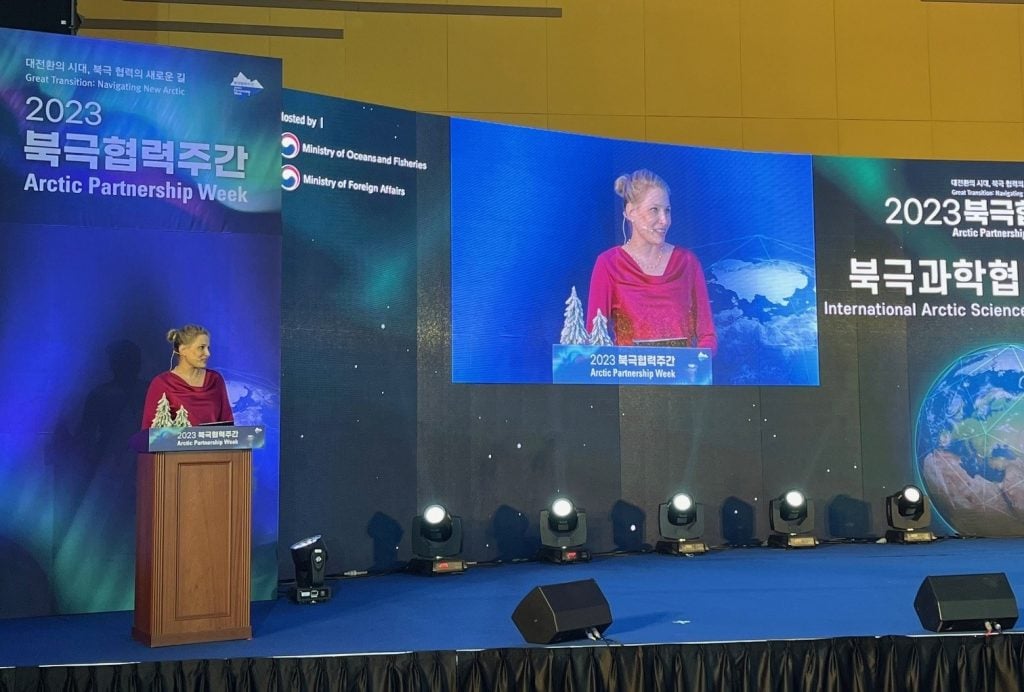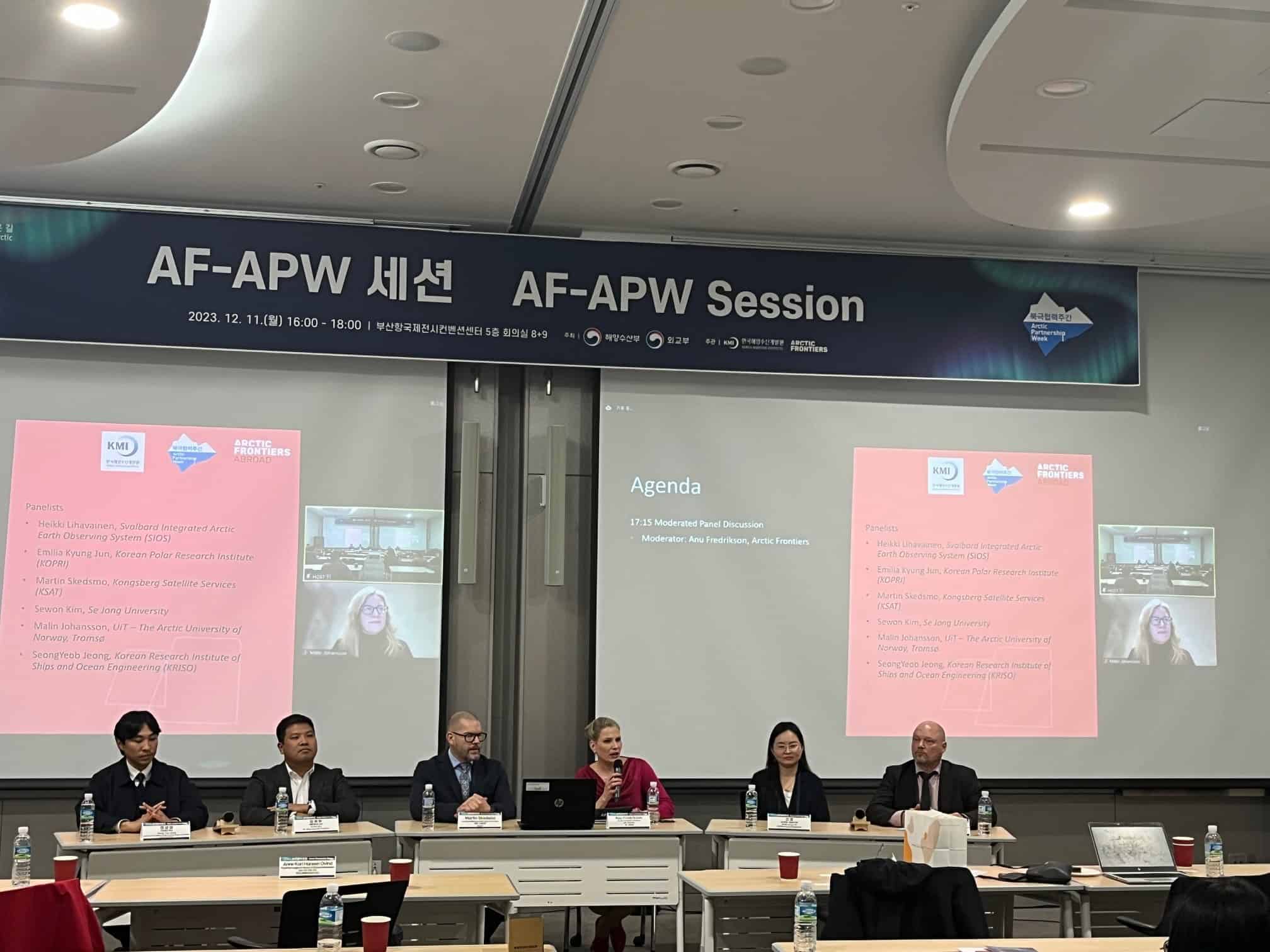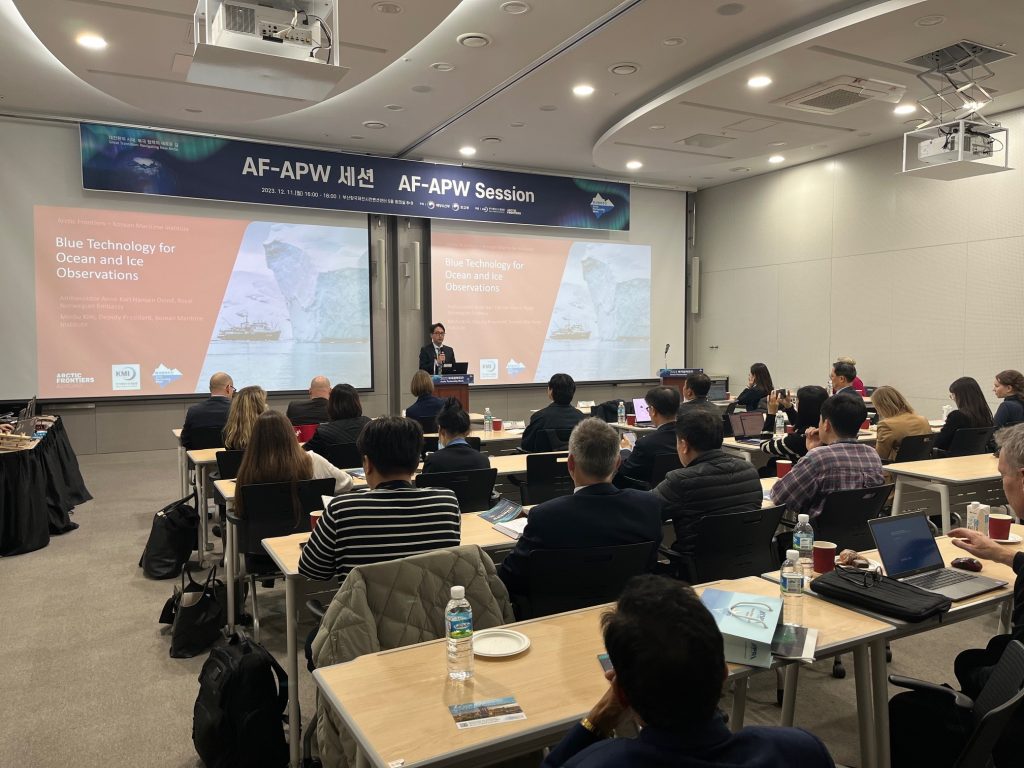Arctic Frontiers, in collaboration with the Korean Maritime Institute (KMI), held an Abroad seminar at the 2023 Arctic Partnership Week in Busan in December focusing on ‘Blue Technology for Ocean and Ice Observations’.
Busan, South Korea, has one of the largest and most active ports in the world and over 99% of Korea’s trade relies on shipping. Similarly, Norway is a coastal nation, working towards electrifying ports and managing activities sustainably. Numerous research institutes in both nations are focusing on developing new technology and methods for reducing greenhouse gas emissions from shipping, and data providers are now able to observe far more of the oceans. We therefore gathered experts from Norway and Korea to highlight these developments and to share their knowledge for enhanced collaboration.


Following the opening of the session by Vice President of KMI, Dr MinSu Kim and Ambassador of Norway to the Republic of Korea, Anne Kari Hansen Ovind, moderator of the session, Anu Fredrikson, Executive Director of Arctic Frontiers, welcomed the six speakers to present their work.
‘Between 2013 and 2019, shipping activities inside the Arctic increased by 25% and this is likely to continue to rise with the declining sea ice in the future’, highlighted the Head of the International Maritime Research Centre at the Korea Research Institute of Ships and Ocean Engineering (KRISO), Dr Seong Yeob Jeong. However, a decrease of sea ice in the long-term, does not equate to a reduction in risk. Dr Jeong is currently working on enhancing the safety of container ships which experience ice riming and instability when traversing through icy waters.
Dr Malin Johansson, Assistant Professor at UiT – The Arctic University of Norway, Tromsø, showed a series of satellite images revealing the dangerous sea ice conditions, and highlighting the complex path which ships must take to pass through the ice. Currently, hand-drawn sea ice maps which chart the sea ice thickness and extent are used by Captains and ship operators. Artificial Intelligence (AI) has the ability to now produce maps quicker and with more detail, but the accuracy still needs evaluating before most ship operators will trust them, explained Dr Johansson.
Another avenue for increasing the sustainability of shipping in the Arctic is by researching alternative fuel options. Dr Sewon Kim from Sejong University presented developments within liquid hydrogen fuels and nuclear propulsion. Whilst regular use is likely to be 30 years away, there are positive results from early tests.

All of the researchers expressed a need for higher resolution data and more access to real-time observations and satellite products. Mr Martin Skedsmo, Key Account Manager at Kongsberg Satellite Services (KSAT) showed how satellite products can be used to track illegal shipping vessels, and how similar algorithms can also be used to locate and track icebergs in the Arctic Ocean. Utilising data and machine learning algorithms in this way can reduce illegal fishing practices and enhance safety of maritime activities. Martin also highlighted the importance of bringing scientists together with data providers, so that the needs of the scientists are taken into account when developing new satellite sensors and tools.
Dr Emilia Kyung Jin, Principal Scientist at the Korean Polar Research Institute (KOPRI) is currently investigating ways of reducing greenhouse gas emissions associated with intensive research field campaigns. Fieldwork in the Polar Regions is energy intensive and involves large ships, aircraft and transporting scientists many thousands of kilometers. However, observations are essential to understand the environment and changes we are facing. Dr Jin explained that there is a balance required between increasing measurements of the Arctic and reducing emissions from this. International collaboration between research institutes is one way to do this.
Dr Heikki Lihavainen, Director of the Svalbard Integrated Arctic Earth Observing System (SIOS) highlighted additional ways that science facilitators and data providers can reduce emissions whilst ensuring good Artic coverage. Dr Lihavainen also commented that whilst we have more observations now than ever before, we are still lacking a complete picture of the High Arctic, especially regarding the impact of air pollution and black carbon.
Following the presentations, the six speakers from Norway and The Republic of Korea discussed their work further during a moderated panel discussion. ‘International collaboration and a concerted effort between scientists, policy makers and data providers will encourage innovative technologies and solutions for observational gaps and blue economy development’ concluded moderator Anu Fredrikson.